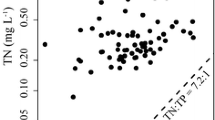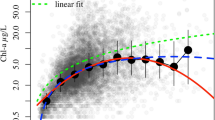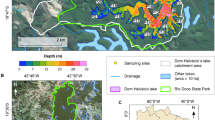Abstract
Dissolved organic matter (DOM) influences inland water ecosystems through its light absorbing qualities. We investigated how pH affects light absorption by DOM with pH manipulation experiments and with data from two lake surveys. We hypothesized that: (1) light absorption and photobleaching of DOM would increase with increasing pH, and (2) as a result of photobleaching, molar absorption (i.e. light absorbance at 440 nm/dissolved organic carbon concentration) would decrease among lakes with increasing pH. In experiments with filtered lake water both initial light absorption and photobleaching rates increased at higher (i.e. more basic) pH along with a concomitant shift in the size of DOM toward larger colloidal materials measured by dynamic light scattering (DLS). Both scanning electron microscopy (SEM) and atom force microscopy (AFM) revealed large colloidal to particulate-sized organic matter in alkaline relative to acidic treatments. In the lake surveys, molar absorption coefficients were negatively related to pH across gradients similar to the experiments. Our results are consistent with a conceptual model in which at low pH DOM polymers and colloids are condensed limiting exposure of chromophores to light; at higher pH, polymers and colloids are expanded exposing chromophores to light resulting in greater initial light absorption and faster photobleaching. Hence, water transparency, which is significantly controlled by DOM, is sensitive to environmental changes that influence the pH and chemical composition of inland waters.






Similar content being viewed by others
References
Aiken GR, Malcolm RL (1987) Molecular weight of aquatic fulvic acids by vapor pressure osmometry. Geochim Cosmochim Acta 51:2177–2184
Baalousha M, Motelica-Heino M, Coustumer PL (2006) Conformation and size of humic substances: effects of major cation concentration and type, pH, salinity, and residence time. Colloids Surface A Physicochem Eng Aspects 272:48–55
Bricaud A, Morel A, Prieur L (1981) Absorption by dissolved organic-matter of the sea (yellow substance) in the UV and visible domains. Limnol Oceanogr 26:43–53
Carignan R, Perceval O, Prairie YT, Parkes A. (2007) Développement d’un outil de prévention de l’eutrophisation des lacs des Laurentides et de L’Estrie. Report to the Ministère du Développement durable et des Parcs
Chin W-C, Orellana MC, Verdugo P (1998) Spontaneous assembly of marine dissolved organic matter into polymer gels. Nature 391:568–572
Cole JJ, Prairie YT, Caraco NF, McDowell WH, Tranvik LJ, Striegl RG, Duarte CM, Kortelainen P, Downing JA, Middelburg JJ, Melack J (2007) Plumbing the global carbon cycle: integrating inland waters into the terrestrial carbon budget. Ecosystems 10:171–184
Cuthbert D, del Giorgio P (1992) Toward a standard method of measuring color in freshwater. Limnol Oceanogr 37:1319–1326
de Vincente I, Ortega-Reuerta E, Romera O, Morales-Baquero R, Reche I (2009) Contribution of transparent exopolymer particles to carbon sinking flux in an oligotrophic reservoir. Biogeochemistry. doi:10:1007/s10533-009-9342-8
De Wit HA, Mulder J, Hindar A, Hole L (2007) Long-term increase in dissolved organic carbon in streamwaters in Norway in response to reduced acid deposition. Environ Sci Technol 41:7706–7713
Del Vecchio R, Blough NV (2002) Photobleaching of chromophoric dissolved organic matter in natural waters: kinetics and modeling. Mar Chem 78:231–253
Findlay S, McDowell WH, Fischer D, Pace ML, Caraco N, Kaushal SS, Weathers KC (2010) Total carbon analysis may overestimate organic carbon content of fresh waters in the presence of high dissolved inorganic carbon. Limnol Oceanogr Methods 8:196–201
Friskin BJ (2001) Revisiting the method of cumulants for the analysis of dynamic light-scatter data. Appl Optics 40:4087–4091
Karlsson J, Bystrom P, Ask J, Ask P, Persson L, Jansson M (2009) Light limitation of nutrient poor lake ecosystems. Nature 460:506–509
Kelton N, Molot LA, Dillon PJ (2007) Spectrofluorometric properties of dissolved organic matter from central and southern Ontario streams. Water Res 41:638–646
Kirk JTO (1994) Light and photosynthesis in aquatic ecosystems. Cambridge University Press, Cambridge
Koppel DE (1972) Analysis of macromolecular polydispersity in intensity correlation spectroscopy: the method of cumulants. J Chem Phys 57:4814–4820. doi:10.1063/1.1678153
Lindell MJ, Graneli W, Tranvik LJ (1995) Enhanced bacterial growth in response to photochemical transformation of dissolved organic matter. Limnol Oceanogr 40:195–199
McKnight DM, Boyer EW, Westerhoff PK, Doran PT, Kulbe T, Andersen DT (2001) Spectrofluorometric characterization of dissolved organic matter for indication of precursor organic material and aromaticity. Limnol Oceanogr 46:38–48
Miller WL (1998) Effects of UV radiation on aquatic humus: photochemical principles and experimental considerations. In: Hessen DO, Tranvik LJ (eds) Aquatic humic substances: ecology and biogeochemistry. Springer-Verlag, New York
Molot LA, Dillon PJ (1997) Photolytic regulation of dissolved organic carbon in northern lakes. Global Biogeochem Cycle 11:357–365
Molot LA, Hudson JJ, Dillon PJ, Miller SA (2005) Effect of pH on photo-oxidation of dissolved organic carbon by hydroxyl radicals in a coloured softwater stream. Aquat Sci 67:189–195
Monteith DT et al (2007) Dissolved organic carbon trends resulting from changes in atmospheric deposition chemistry. Nature 450:537–539
Morris DP, Hargreaves BR (1997) The role of photochemical degradation of dissolved organic carbon in regulating the UV transparency of three lakes on the Pocono Plateau. Limnol Oceanogr 42:239–249
Morris DP, Zagarese H, Williamson CE, Balseiro EG, Hargreaves BR, Modenutti B, Moeller R, Queimalinos XX (1995) The attenuation of solar UV radiation in lakes and the role of dissolved organic carbon. Limnol Oceanogr 40:1381–1391
Myneni SCB, Brown JT, Martinez GA, Meyer-Ilse W (1999) Imaging of humic substance macromolecular structures in water and soils. Science 286:1335–1337
Osburne CL, Zagarese HE, Morris DP, Hargreaves BR, Cravero WE (2001) Calculation of spectral weighting functions for the solar photobleaching of chromophoric dissolved organic matter in temperate lakes. Limnol Oceanogr 46:1455–1467
Otsuki A, Wetzel RG (1973) Interaction of yellow organic acids with calcium carbonate in freshwater. Limnol Oceanogr 18:490–493
Pace ML, Cole JJ (2002) Synchronous variation of dissolved organic carbon in lakes. Limnol Oceanogr 47:333–342
Prairie YT (2008) Carbocentric limnology: looking back, looking forward. Can J Fish Aquat Sci 65:54–548
Reche I, Pace ML, Cole JJ (1998) Interactions of photobleaching and inorganic nutrients in determining bacterial growth on colored dissolved organic carbon. Microb Ecol 36:270–280
Reche I, Pace ML, Cole JJ (1999) Relationship of trophic and chemical conditions to photobleaching of dissolved organic matter in lake ecosystems. Biogeochemistry 44:259–280
Reche I, Pulido-Villena E, Conde-Porcuna JM, Carrillo P (2001) Photoreactivity of dissolved organic matter from high-mountain lakes of Sierra Nevada, Spain. Arct Antarct Alp Res 33:426–434
Santschi PH, Balnois E, Wilkinson K, Zhang J, Buffle J, Guo L (1998) Fibrillar polysaccharides in marine macromolecular organic matter, as imaged by atomic force microscopy and transmission electron microscopy. Limnol Oceanogr 43:896–908
Tranvik LJ, Jansson M (2002) Climate change—export of organic carbon. Nature 415:861–862
Tranvik LJ et al (2009) Lakes and reservoirs as regulators of carbon cycling and climate. Limnol Oceanogr 54:2298–2314
Tzortziou M, Osburn CL, Neale PJ (2007) Photobleaching of dissolved organic material from tidal marsh-estuarine system of the Chesapeake Bay. Photochem Photobiol 83:782–792
Verdugo P, Alldredge AL, Azam F, Kirchman DL, Passow U, Santschi PH (2004) The oceanic gel phase: a bridge in the DOM-POM continuum. Mar Chem 92:67–85
von Wachenfeldt E, Tranvik LJ (2008) Sedimentation in boreal lakes—the role of flocculation of allochthonous dissolved organic matter in the water column. Ecosystems 11:803–814
Wetzel RG (2001) Limnology: lake and river ecosystems. Academic Press, Burlington
Wetzel RG, Hatcher PG, Bianchi TS (1995) Natural photolysis by ultraviolet irradiance of recalcitrant dissolved organic matter to simple substrates for rapid bacterial metabolism. Limnol Oceanogr 40:1369–1380
Williamson CE, Morris DP, Pace ML, Olson OG (1999) Dissolved organic carbon and nutrients as regulators of lake ecosystems: resurrection of a more integrated paradigm. Limnol Oceanogr 44:795–803
Wilson HF, Xenopoulos MA (2009) Effects of agricultural land use on the composition of fluvial dissolved organic matter. Nat Geosci 2:37–41
Zepp RG, Faust BC, Hoigné J (1992) Hydroxyl radical formation in aqueous reactions (pH 3–8) of iron (II) with hydrogen-peroxide: the photo-Fenton reaction. Environ Sci Technol 26:313–319
Acknowledgements
We thank D. Thomas, S. Scanga, M. Van de Bogert, and J Coloso for help in the lab and field. E. Urea helped with microscopy, and F. Perfectti helped with the conceptual figure. Comments by two anonymous reviewers improved the final version of this paper. Our research was supported by grants from the National Science Foundation, USA (DEB0716869, DEB0715054), Spanish Ministry of Science and Technology (DISPAR, CGL2005-000076, MAT2009-14234-C03-02), Andalusian Research Ministry (Excellence Project FQM230-2009), and the National Research Council of Canada.
Author information
Authors and Affiliations
Corresponding author
Rights and permissions
About this article
Cite this article
Pace, M.L., Reche, I., Cole, J.J. et al. pH change induces shifts in the size and light absorption of dissolved organic matter. Biogeochemistry 108, 109–118 (2012). https://doi.org/10.1007/s10533-011-9576-0
Received:
Accepted:
Published:
Issue Date:
DOI: https://doi.org/10.1007/s10533-011-9576-0




